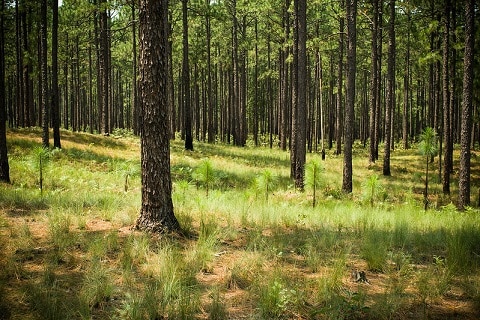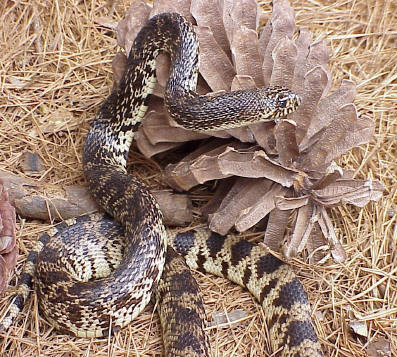Corridor Use Feeding Ecology and Habitat Louisiana Pine Snake

In the south-eastern USA, there's a serpent so rare that it's normal to find only a couple after thousands of hours searching for them. It's something of a cursed snake among hepo-enthusiasts, and normally appears to random dog-walkers rather than people spending years on a dedicated search. This snake is the Louisiana pinesnake, also known as Pituophis ruthveni.
The Louisiana pinesnake is generally regarded as the rarest snake in North America. It lives solely in east Texas and mid-west Louisiana, and its domain is the ultra-specific habitat of longleaf pine forests. Since the 1900s, these forests have been felled by the logging industry so that in Texas, only 7% of state's 1935 longleaf pine is still in place, which was already only 3% of the amount before 1870.
Consequently, Pituophis ruthveni is now confined to a tiny 4 counties in Louisiana and 5 counties at most in Texas, down from 14 historical counties in Texas in 9 in Louisiana. In Texas, a couple of the rare spots include the south of Angelina forest, and the south of Sabine forest. The Louisiana pinesnake was on the FDA's watchlist for 34 years until 2018, when it was finally labelled as "threatened" species.
| 2 | Thick-bodied and powerful |

The fact that this snake is impossible to spot is more impressive considering that it's a fairly long snake. Adult Louisiana pinesnakes measure 122-142cm on average, and they have a thick and muscular body. Within 1 year they reach 61-91cm and within 2 years they stretch out to 91-122cm. At 120cm they become sexually mature, and the longest confirmed Louisiana pinesnake was 1.8 metres, a snake recorded in 1998. This probably wasn't close to the maximum length considering how rarely they're caught for analysis.
The Louisiana pinesnake is mostly black and beige, with a variety of complex patterns: larger black patches on their back, followed by smaller black lines and patches on their sides. This is one of those snake species where the head barely widens compared to the neck, tapering in without stopping. It's the exact opposite of the huge triangular head of a king cobra.
Louisiana pinesnakes make an extremely loud hiss, thanks to a small flap at the entrance to their windpipe. Their pupils are round and black, and their snouts are extra pointed for burrowing into gopher tunnels.

The Louisiana pinesnake is the holder of not just one, but two American records. It's the rarest snake and it produces by far the largest eggs of any North American snake species.
These eggs are white and long, and look more like unfinished sausages about to roll down the conveyor belt in a factory. The dimensions can reach 13cm long by 5.1cm wide, the size of several chicken eggs. Only so many of these boulders can fit inside the snake's body and consequently, they lay a very low number of eggs per clutch at 4-5. Other pine snakes also lay huge eggs, but the Louisiana pine snake just edges past them. Not surprisingly, the hatchlings can be huge as well, being one third of their mother's body length at 56cm.
Unfortunately, these egg characteristics may be hurting the species, as the lower number slows down their reproduction rate significantly, even when recolonising newly protected forests. In captive breeding programs, they tend to lay only 1 or 2 eggs.
| 4 | Spends 59% of daylight underground |

Rather than a constantly prowling farmyard snake, the Louisiana pinesnake leads a cosy life underground, spending approximately 59% of daylight hours below ground in total (study). This is a diurnal (day-faring) species, and at night they dwell underground almost exclusively. Their favourite hideyholes by far are Baird's pocket gopher (Geomys breviceps) burrows, a small mammal which shares their niche habitat of longleaf pine forests.
These burrows can be vast, 180 metre long labyrinths, but the Louisiana pinesnake tends to hang out near the entrances, just 10-20cm below the surface. More rarely, they can dwell in rotting tree stumps and the nearby root canals, and very occasionally in the burrows of the nine-banded armadillo species.
The Louisiana pinesnake is neither lazy nor overly adventurous. On 54% of days, they moved less than 10 metres, and returned to their burrow in time for sunset. But on another 46% they migrated much longer distances, with the study finding an average of 163m, usually to find a fresh new burrow to shelter in. Old burrows can start crumbling, start being filled in, or the snake may have eaten all the gophers that use it.
| 5 | Its bosom buddy, the pocket gopher |

The Louisiana pinesnake's existence is intricately tied to one species, more so than almost any other snake. Without Baird's pocket gophers (not to be confused with plains pocket gophers), their precious burrows wouldn't exist and their food supply would dry out to a trickle. They're also known to eat eastern moles, cotton rats, white-footed mice, harvest mice and turtle eggs, but pocket gophers make up the vast majority of their calories.
Baird's pocket gophers are exclusive to eastern Texas, eastern Oklahoma, western Louisiana and south-west Arkansas, which isn't too dissimilar a range from the Louisiana pinesnake. They measure 19-22cm long from head to tail, and their body shape is adapted specially for digging in the loose soils below pineleaf forests. They have thick, broad shoulders, and a cylindrical shaped body to avoid getting stuck. The majority of their weight is in their upper bodies.
Their huge, 180 metre long den systems mean that they're safe from most predators – except the Louisiana pinesnake. When biologists search for the elusive Louisiana pinesnake, they always search for pocket gophers first.
| 6 | Why their habitat is ultra rare |

The felling of longleaf forest has been a nightmare for the Louisiana pinesnake because it's the only tree type (except shortleaf pine) that meets an ultra specific set of habitat requirements. Longleaf trees naturally grow far apart, leaving large gaps in the canopies where the warm Louisiana sun can shine through all day. This is important to Louisiana pinesnakes because their pocket gopher prey requires sandier, drier soils in order to dig their burrows (rather than hard clay). They also require a thick covering of herbaceous vegetation rather than a barren forest floor, which only sunlight can make possible.
Most of the replanted forests in east Texas and west Louisiana haven't been longleaf, but slash pine or loblolly forests instead. These grow in much denser canopies and are felled every 40 year in commercial lumbering operations. There's also a much poorer variety of plant fauna at their feet.
Again, this feeds back to the species' endless dance with the pocket gopher, as the gopher is dependent on herbaceous vegetation like grasses to survive. The species has rare cellulase-producing enzymes in its stomach to digest these grasses.
| 7 | Wildfires are beneficial for them |

When most people think of wildfires, they picture scared koala bears hugging their rescuers, but for Louisiana pinesnakes they're something of a secret ingredient. Longleaf forests are what's called a "fire climax" community, an ecosystem which thrives when it suffers from regular, moderate strength wildfires.
These thrive on the longleaf pine's natural dryness, and the idea is to burn off the mid-story vegetation without impacting the towering, well-spaced trees above. This allows just enough sunlight to feed the thick, ground level vegetation which pocket gophers (and therefore Louisiana pine snakes) thrive in. The problem is that with efforts to control wildfires, this natural cycle is being halted.
Louisiana pinesnakes have a natural instinct for dodging these flames. Scientists monitored 9 snakes from 1994 to 1997 and found that all 9 survived local wildfires without a single burn. On February 25th 1994, one snake sat patiently while a burning, crackling wildfire approached across the forest floor, at a rate of 5 metres per minute. The flames were flickering at a height of 0.5-0.8 metres.
The snake didn't react until the flames approached to 15 metres. Then it slithered towards the flames for several metres, and vanished into the safety of an underground gopher burrow. The scientists had also attached a temperature monitor, and as the snake vanished the reading fell from 27 to 11-14 degrees centigrade.
| 8 | A new way to monitor them |

The average reptile enthusiast could spend years trying to find this snake while driving around aimlessly, but as of 2021 scientists have invented a new technological system for finding this elusive species. Some scientists travelled to the Fort Polk army base in western Louisiana, where the Department of Defence had recently released some Louisiana pinesnakes into the wild. They'd stored the DNA samples of those snakes in their on site lab, so the scientists took these and journeyed to the release site in the forest.
They then collected soil samples from where VHF tracking systems had proven the snakes to have visited, and searched for DNA within them. It was a eureka moment, as the DNA matched the original lab samples precisely, proving that the snakes had been there. The DNA likely came from saliva or skin cells dropped as the skin slithered along.
This was hailed a gamechanging new advancement for tracking the species, freeing them from the impossible task of catching them in action. Overall, the scientists found intact DNA in 100% of the wild release sites and 60% of the VHF detection sites.
| 9 | Could the species be saved? |

Things are going badly, but things are also going well in the quest to save the species. On May 1st 2012, three male Louisiana pine snakes were released in Kisatchie forest in Louisiana, and this followed 27 that were released over the previous years. The problem was that only 20 captive snakes had hatched in 2010, and only 14 in 2011, despite 18 zoos keeping the species nationwide. This was way below the projection of 50 to 100, and many of the captive females were getting older as well.
The real key is to protect the longleaf habitat and in 2020, a huge deal was announced to accomplish exactly that. It was the largest deal between the U.S. Fish and Wildlife Service and a private landowner in history, and protected all 667,000 acres of timberland owned by the Weyerhaeuser logging company. All of this lay inside the Louisiana pinesnake's historical range, and the company promised to convert 444 acres of loblolly into new longleaf pine forests. In the second focus area, they planned to thin out 1,383 acres of canopy to make the habitat more suitable, to protect the secret snakes.
| 10 | Chases prey through tunnels |

For such an elusive snake, the Louisiana pinesnake is far from a shrinking violet. The rare people who have met one describe it as aggressive, hissing fiercely at the threat and widening its head in a show of intimidation. When hunting their staple of pocket gophers, they're extremely adept predators. When they enter burrows, they slither forward at an extremely fast pace. Usually, the gophers frantically attempt to backfill the burrow with loose soil, but one study found that this succeeded only 5% of the time. Usually, the Louisiana pinesnake used its angled scaled nose to brush this soil out the way with rapid side to side movements.
When it finally reaches the fleeing gopher, the snake has three strategies. In strategy 1, it slithers to approximately one third past the gopher's body and then pins it to the side of the tight burrow chamber. In strategy 2, it slithers past the gopher, doubles back, and pins it using two lengths of its body.
The final strategy is to seize the gopher with its jaws and then constrict. Technically, the Louisiana pinesnake is a constrictor, but its pinning methods are different to the vast majority of constrictors. It was once compared to its northern pinesnake cousin in a study, and the latter behaved much more cautiously in burrow systems.
Source: https://snakeradar.com/10-facts-about-the-louisiana-pinesnake/
0 Response to "Corridor Use Feeding Ecology and Habitat Louisiana Pine Snake"
Post a Comment